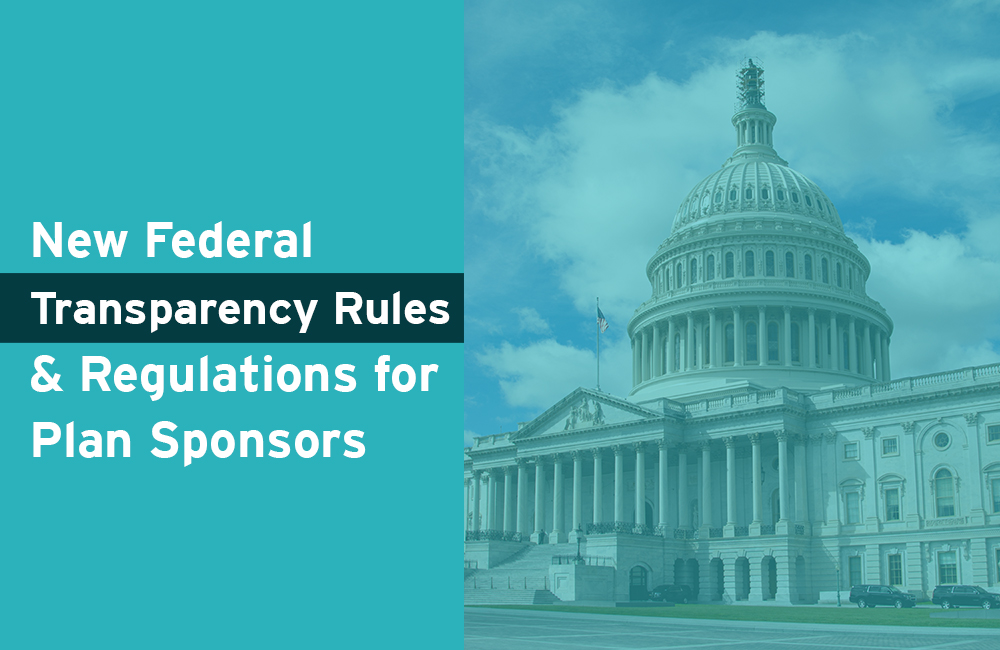
New Federal Transparency Rules and Regulations for Plan Sponsors
A lot has happened over the past two years in relation to price transparency; executive and Congressional actions have led to new federal rules and regulations for health systems, benefit administrators, and plan sponsors. These rules have promise to make public the type of information we need to create an effective health care market, however there are a lot of moving parts.
This article will act as a guide and timeline employers can use to follow along with the federal rules, their responsibilities as plan sponsors, and key dates for implementation.
Hospital Price Transparency
In June of 2019, the White House issued an executive order aimed at improving hospital price transparency. The Centers for Medicare & Medicaid Services (CMS) thereafter provided the hospital price transparency rule. External Link. Opens in new window.:
Effective Jan. 1, 2021: Hospitals are required to provide clear, accessible pricing information online about the items and services they provide in a consumer-friendly format and as a comprehensive machine-readable file.
Some hospitals have complied with the rule, but many have not. In July of this year, CMS doubled down on its efforts to get hospitals to disclose their rates by increasing the penalty from a flat $300/day to $10 per bed per day for larger hospitals.
Transparency in Coverage
In October 2020, The Centers for Medicare & Medicaid Services (CMS) issued their final Transparency in Coverage ruling. External Link. Opens in new window. that applies to health plans. The final rule requires group health insurers and self-insured plans to disclose their rates and other price information for all covered billable services. Those plan obligations are to be phased over a three-year span.
Recently, the Department of Labor announced a delay in enforcement for certain provisions of the Transparency in Coverage Rule. External Link. Opens in new window.. These rules now have the following enforcement dates:
July 1, 2022: Insurance carriers and self-insured plans must publicly disclose machine-readable files for in-network provider negotiated rates and out-of-network allowable amounts. These files must be prominently posted on a free-to-access, publicly available website and updated monthly.
(In partnership with the TPAs of our employer-members, The Alliance is actively working on gaining compliance with this provision. As additional guidance becomes available on the remaining provisions, we will gladly collaborate with our employers’ other health benefit partners to assist them in complying with this rule.)
Enforcement is indefinitely deferred pending future rulemaking in regard to disclosures relating to prescription drugs. These requirements were in effect for January 1 prior to deferment.
Jan. 1, 2023: Insurance carriers and self-insured plans must provide consumers with cost-sharing information for 500 popular “shoppable” services online – and make paper copies available upon request.
Jan. 1, 2024: Insurance and self-insured plans must provide consumers with cost-sharing information for all covered, billable services.
Consolidated Appropriations Act & No Surprises Act
Near the end of 2020, Congress passed an omnibus spending measure (H.R.133 – Consolidated Appropriations Act, 2021. External Link. Opens in new window.) which included a number of transparency provisions, including those set forth in the No Surprises Act. External Link. Opens in new window..
CAA Transparency Provisions | Enforcement delayed until Dec. 27, 2022: Insurance carriers and self-funded plans must submit certain plan and prescription drug information to HHS including:
- The 50 most frequently dispensed prescription drugs (and the total number of claims for each), the 50 most costly prescription drugs, and the 50 prescription drugs with the greatest increase in plan expenditures.
- The total spending by the plan broken down by health care service type.
- The average monthly premiums paid by plan participants and employers.
- Rebates, fees, and other renumeration paid by drug manufacturers to the plan and any reduction in premiums or out-of-pocket costs as it relates to rebates.
Due to the enforcement delay, plans will be expected to submit 2020 and 2021 data by December 27, 2022 and then annually by June 1 for subsequent years.
No Surprises Act Provisions | Effective Jan. 1, 2022 except where noted: requires fully insured and self-insured plans to:
- Offer price comparison guidance online and by phone that shows the plan participant the amount they would be responsible for paying to providers under the plan for a particular service (enforcement delayed to January 1, 2023).
- Ensure provider directories are accurate and to keep current with updates every 90 days.
- Provide an Advanced Explanation of Benefits to plan participants for scheduled services with an estimate of their cost-sharing responsibilities (enforcement deferred until rulemaking takes place).
- Insurance cards need to include in-network and out-of-network deductibles and maximum out-of-pocket costs.
Next Steps
The public comment period has closed for many of the new transparency rules, apart from additional rulemaking that will be forthcoming on certain provisions of the No Surprises Act. However, considering the administrative burdens these rules impose on health plans, requests have been made for extended grace periods or longer “phase-in” periods. We will keep our employer-members apprised of updates as the laws change and take effect.
For a deeper dive into this topic from the employer angle, The Alliance will be hosting a Health Policy Regulation webinar on Thursday, October 14. External Link. Opens in new window.. John Barlament, Partner at the firm Quarles & Brady, will discuss topics like the No Surprises Act, changes to Mental Health Parity and Addiction Equity (MHPAEA) reporting, American Rescue Plan Act (ARPA), advanced EOB provisions, transparency provisions, and all the legal ramifications for employers. Learn more and register here. External Link. Opens in new window..








